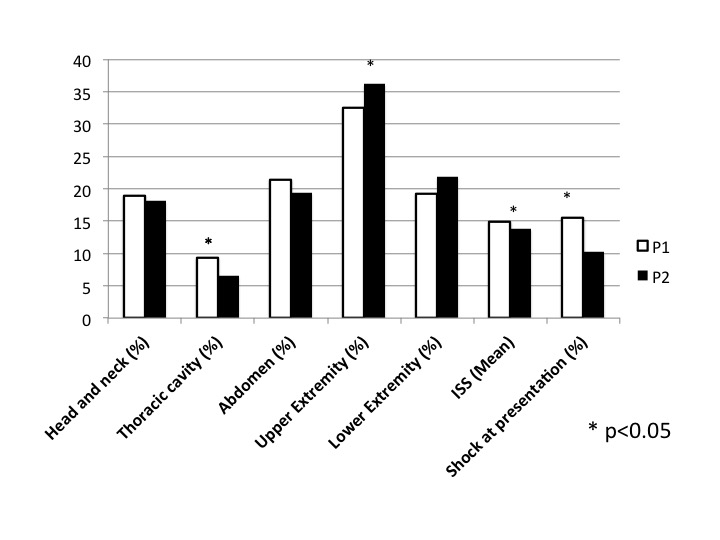Epidemiology and Trends in Outcomes of Pediatric Vascular Injuries in the United States
Mohammad H. Eslami, MD, MPH1, Efthymios D. Avgerinos, MD1, Jeffrey J. Siracuse, MD2, Alik Farber, MD2.
1University of Pittsburgh Medical School, Pittsburgh, PA, USA, 2Boston University School of Medicine, Boston, MA, USA.
Objectives: The purpose of this analysis is to study the contemporary epidemiology and outcomes after pediatric vascular injuries (Ped VI).
Methods: National Trauma Data Bank (2002-2012) was queried to identify children (0-16) who sustained Ped VI. Patients were categorized based on their demographics, locations and mechanisms of Ped VI as well as presenting trauma severity (injury severity score (ISS) and shock). The study period was divided into two 5-year periods (P1:2002-2006, P2:2007-2012) to study the trends in Ped VI presentation and outcomes (hospital death and extended length of stay(LOS >8 days)). Adjusted analyses were performed to identify variables independently associated with hospital death or LOS after Ped VI.
Results: Analyses were performed on 3408 cases; male (73.7%) and Caucasian (52.8%) with mean age of 10.5±4.5 years. The US Southern region saw the highest increase in Ped VI rates (P2 vs P1: 38.3% vs. 25.0%, P<.05). Blunt injuries constituted the majority of Ped VI (57%). Firearm (36.9%) and motor vehicle trauma (MVT) (34%) were the most common mechanism of injury resulting in mortality. Although there was a significant decrease in MVT rates (P2 vs. P1: 17.4% vs. 22.6%, p<.05), firearm Ped VI rates were unchanged. The anatomical location of Ped VI is summarized in Figure below: upper extremity injuries were most common (34.9%). ISS and shock were significantly decreased during P2 (Figure). Overall mortality occurred in 7.9% of patients which significantly decreased (P2 vs. P1: 10.9% vs. 6.3%, p<.001) without a significant change in LOS. Adjusted analyses indicated that the odds of mortality decreased by 32% during P2 (p=.08) and was independently associated with penetrating mechanism of injury (Odds Ratio (OR) 1.97, 95% confidence Interval (CI): 1.21-3.19, p=.005); shock at presentation(OR:5.48; 95% CI: 3.55-8.46, p<.001); and ISS (OR:1.076; 95% CI: 1.06-1.27, p<.001).
Conclusions: We observed a significant decrease in the overall severity of injury and in-hospital mortality concurrent with the observation of a significant decrease in MVT Ped VI rates. Public health policies directed toward firearm safety may further decrease Ped VI and mortality among this vulnerable population. 
Back to 2017 Program




